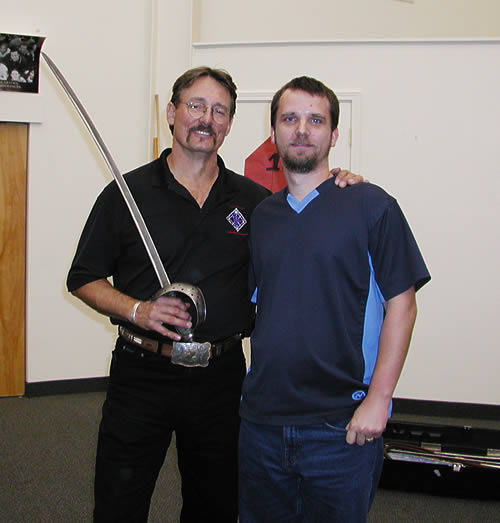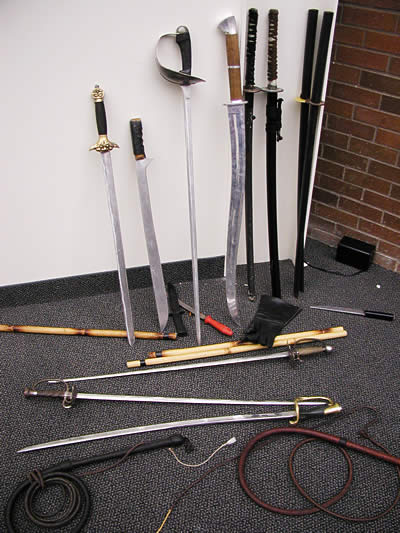Anthony De Longis: Rapier, Wit and Whip

I keep joking that some day soon, Jet Li is going to visit Beaverton. First I found out that Shaowen Yu, a local master and instructor of martial arts I met with some months ago, trained in the same school as Jet in their childhood years. Just a week ago I learned through reading an article in the Oregonian that Anthony De Longis would be presenting a Film Combat Seminar and Lecture here in Beaverton. What caught my attention was the stunning image of Jet Li and Anthony facing off as Huo Yuan Jia (Jet) against "Spanish Fighter" (De Longis) from the recent movie Fearless. I vividly remember the scene where the two engage in a masterful swordplay extravaganza and knew this lecture was something I couldn't pass up. It turns out that the scene as it appears in the film was virtually an improvisation, a "dance" of sorts between Anthony and Jet - amazing talent!
I arrived at Thomas Edison High School this evening with much excitement and anticipation, accompanied by my great friend, Jim. From the get-go it was apparent that Anthony De Longis is an avant-garde in his field, and his lecture revealed an exquisite passion for the martial arts. With 35 years' experience in a variety of fighting styles and applications, his favorite disciplines include mastery of the bull whip and most bladed weaponry. He is also an accomplished hand-to-hand martial artist, proficient in a number of styles. He was eager to give his presentation this evening and started off by showing his demo reel, an incredible portfolio. He trained Michelle Pfeiffer to be Catwoman in Batman Returns, has worked with Jet Li, Tom Cruise, Charlton Heston, Yuen Woo Ping, Patrick Swayze, and choreographed or starred in an almost ridiculous number of movies, TV series and theatre productions.
De Longis communicates an uncanny zealousness for martial arts that I personally find rare in westerners. For some odd reason it seems a pattern that Americans just "don't get it", and their movements and posture often don't reflect that same Wu Shu beauty and cultural verve. Perhaps it is part of an artist's growing up in China or other countries where martial arts is virtually a religion that gives them this advantage or impression. Anthony is an unmistakable exception to this stereotypical sway. There was an admirable precision and method to each of his movements. None of them seemed haphazard.
As Anthony De Longis put it, "Style without substance is just eye candy." There were several key principles presented in this evening's lecture that agree with my own approach to martial arts. First was the tug-of-war between stylistic beauty and combat plausibility. As Anthony demonstrated his martial expertise, he often said, "you would buy this", referring to a sequence of techniques that tell a story. It is an insult to both the artists and the audience to assume flashy movements will be credible and to represent martial arts as a series of flips and extravagant spinning kicks in predictable slow motion. There will always be a certain amount of garish performance for the camera, but it must be balanced with techniques that make sense and that are a reflection of the character's developed personality and style. Poor choreography and cinematography choices cater to the success of satires like Kung Pao and Kung Fu Hustle. An intelligent and critical audience will know authenticity when they see it.

Another of Anthony's communicated principles relates to physics. He emphasized creating a guard that cannot be penetrated. This can be done by aligning a chained bone structure: the elbow behind the hand, and the body in line as well. Stability and strength are achieved by aligning the body as much as possible into a single unit, with mostly undivided intent. My favorite martial art, Taiji, emphasizes such regard for calculated and stable posture, though in a distinctly flowing and elegant fashion. I have been thinking a lot lately about the physics of the human body and how forces such as momentum and motion can be harnessed. I haven't yet honed any specific techniques or theories, but it is hard-pressed on the forefront of my mind. Perhaps some day I'll document my thoughts and develop a series of resulting techniques that reflect my findings. Interestingly enough, I have developed a simple, flowing figure eight hand motion that I might call "Dragon Whip". I am interested to see if it has any martial application because it feels somehow significant. De Longis told us of his aspiration to develop a new form of martial arts based on a single incredibly versatile weapon, the bull-whip. He is perhaps the most well-known whip artist alive today, as it's use is becoming less common. His demonstration of the whip's multi-range potential amazed all who looked on.
The final principle Anthony touched on that I relate to is the passing of knowledge, skill and trades. For these to survive the test of time, they must be taught with a committed eye for detail and with much discipline. The details left out are lost, accepted imperfections have their influence, and the original art gradually morphs into something else entirely. I see t'ai chi as a classic example of this unfortunate truth. I have read that there is (or was) an elite family in China who solely know the highest taiji secrets. These secrets are not taught to anyone outside the family. Therefore, as time passes, the art is lost or weakened - unless the new generations continue to have equal passion and aptitude. Eventually what is labeled "T'ai Chi" will have little or no resemblance to the powerful, internal martial art of years past. In fact, this is already happening. Though it is one of the most widely practiced exercises in the world, it is simply that: an exercise. Many have realized the health benefits of regularly practicing the graceful yet rigorous forms, but few even realize the martial applications. Those that do know may choose to hide this knowledge and take it to their graves. When I asked my first (and only, presently) taiji instructor what the meaning of the movements were, he was unable to answer aside from vague guesses - and I think he had practiced for over 20 years! I am somewhat disappointed by carelessness of those who have the sole ability to pass on knowledge and choose not to, perhaps in their pride. On the other hand, I respect teachers like Anthony De Longis, who pass on their knowledge and techniques accurately to new generations. This is the only way these unique styles can be preserved and appreciated.
Perhaps Anthony's most striking trait, aside from his stupendous skill and knowledge is his striking sense of humor. He was continually cracking laughable jokes and slapstick humor throughout his two hour demonstration and lecture - which was also astoundingly well presented and vastly informative. None of his material or humor seemed packaged or systematically rehearsed or regurgitated. He presented a wealth of intriguing and directly applicable concepts and theories. De Longis' diversified skill reminds me of Bruce Lee's Jeet Kune Do, a unique conglomeration of pared down, effective and adaptable fighting methods of his own rendering. A truly great fighter knows more than manuals full of techniques and their counters. Being able to adapt to an opponent and expose their weaknesses requires not only versatile skill, but an instinct that few possess. Whether Anthony De Longis is a great fighter is of little consequence to me. Rarely is it someone's goal nowadays to be victorious in violence. To be a masterful warrior who contains himself is more admirable to me than a mighty and undefeated champion.